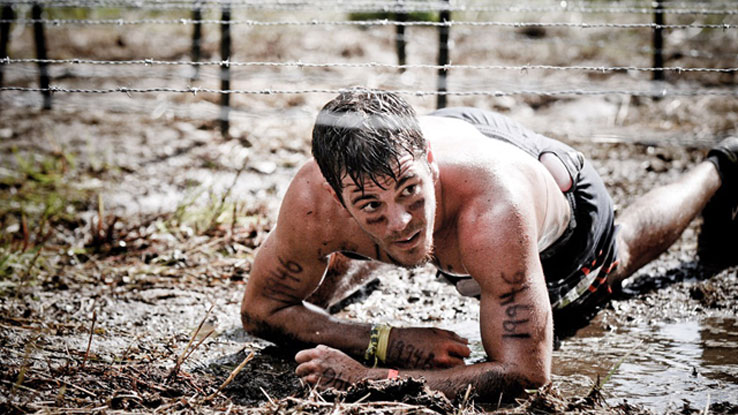Earlier this year I was on a roll – my lifts were climbing, my T-shirts were fitting tighter, and I had a steady stream of aspiring Victoria Secret models sending me boudoir pics along with offers to buy me dinner.
Okay, I made that last one up, but I'm serious when I say my training was going awesome. So much so that my lifting mates changed my gym nickname from Knuckles McGillicuddy (they say I look like an IRA operative – red hair and beard, ya know) to Butter.
Recently, though, they've transitioned me back to Knuckles. After months of progress, mistakes have brought my lifts back to reality.
I didn't take my sudden downturn lightly. My OCD quickly kicked into high gear, and I reviewed my training log like a mad man, looking for my mistakes.
Fortunately, I found them, and wrote them out for you below. These are the five mistakes that killed my progress.

I've held onto every training log I've ever kept since I was fifteen. Reading the vigorous chicken scratches of a boner-driven high school chap always refreshes my training perspective. It prompts me to stay the training course.
Mutated Westside Barbell templates fill the pages of all the logs. Consistent progress abounds on each page. I'm not as persistent with nutrition logs, but the ones I've kept denote progress with simple carb cycling instead of an extravagant scheme.
Lift heavy, lift fast, and lift for reps. Eat the carbs around training. There's nothing fancy scribbled on the pages.
Lately, however, I've put on my fancy pants. To quench the information thirst of clients and to provide them the opportunity to try new training and nutrition strategies, I've turned my body into a laboratory, becoming an experimental fitness martyr. The reason for that is I can't, in good conscience, prescribe for them something I haven't done myself.
Within a few months, Westside's been replaced by several strategies; some new, some old, and some I've made up. Carb cycling gave way to intermittent fasting and other trendy plans.
The result? Rather than continuing a string of PRs, suddenly anything over 70% of my one-rep max feels heavy, and my physique strangely resembles the eerie albino, Powder. Over-experimenting has done me no favors.
Experimentation isn't inherently bad, though; actually, it's inherently good. But when there's a lot of it stuffed into a short block of time, and more than one change is made at once, it becomes a detriment.
Avoid My Mistake
If you're new to training and trying to find your training philosophy, by all means experiment. But give each strategy a chance to work, or not work, and that means at least eight weeks.
Dismiss a program before the eight-week mark and you haven't gathered enough information to make an objective decision. Persistence is necessary to learn about your individual needs.
To learn what your body needs and make the most of your training, find a progressive program – or have one written for you – and stick with it for a year. It's the best way to learn the ins and outs of progression and regression.
If you've been in the iron game for a while, stop shaking your head at me. I know I should've known better.
Traditionally, my programs take shape as Westside programs, but in waves. Rather than the typical volume or intensity build for three weeks followed by the fourth week de-load, I vary the volume each week.
Week one is high, followed by a moderate volume second week. On week three I over-reach and subsequently de-load on week four. It's a schedule I picked up as a teenager and it's proven worthy ever since.
Lately, however, with the installment of new training strategies, this schedule no longer matched the way I loaded volume and intensity. It's a big issue that I ignored. I didn't build enough fatigue during the first three weeks to reduce training on the fourth week, limiting any semblance of a training effect.
The experience has changed my philosophy on de-loading. I used to be a stringent, every-three-week de-loader, but I've learned the error of my ways. I've been taking the fool's approach.
Avoid My Mistake
Unless your current plan is leading you into competition, you're using a Westside template, or you've been training since the Ford Administration, full-blown de-loads every month probably aren't necessary.
Extend training cycles for six to eight weeks by commissioning a moderate volume week – like the second week in the Westside waves – at the end of the training month.
If you live by the numbers and need a quantitative reason to de-load, develop a daily rating scale. Keep it simple. Rate your sleep, daily nutrition, residual stress, how hard each training session feels, post-workout nutrition, feeling of wellbeing, and difficulty of the training week on a scale from one to five.
A one will denote poor or easy; a five will denote excellent or difficult. Training ratings are inversely related to lifestyle ratings.
If you start noticing a lot of twos and threes for sleep, nutrition, and wellbeing, while training difficulty creeps toward five, then you know it's time to de-load. Keep this scale in your log and over time you'll notice trends that make developing your schedule easier.
The short of it – don't de-load unless you have to.

I wish I had my own Bob Cratchit to keep my biological ledgers. In my head, I see him using a quill pen and jotting notes on my workload, training program, and sleep schedule.
I also see myself looking over his shoulder, sporting bodacious red mutton chops and a top hat and, unlike Scrooge, saying, "Nice job, old boy!"
But sadly, since Mr. Cratchit isn't tracking my stress, I have to do it myself. And I've been doing a shitty job because I've forgotten the basics.
Early on in kinesiology and exercise science we're taught that the body recognizes training as a disruption in homeostasis – it responds systemically in proportion to the stress.
Outside of training, however, anything that elicits a stress response also disrupts homeostasis. Combine life stressors with training stress and you can easily redline your stress meter.
In other words, your training stress must exist in relation to the rest of your stressors, not vice versa.
Travelling the Eastern Seaboard, writing 2,000 words per day, training clients, and sleeping less than 7 hours per night brews a lot of stress. Plan a full training block on top of this shaken-not-stirred stress cocktail and training adaptations are kaput. The nervous and immune systems also take a swift kick to the gonads.
When considering my extraneous stress, the training load I took on was asinine – an over-compensation in response to my excessive de-loads. But I didn't get away with it – I cooked the books and got caught.
Now progress is non-existent; I'm on the shallow part of a downward slide. I haven't hit bottom yet, but if I don't mind my ways I'll be there soon.
Avoid My Mistake
Start by using the rating scale I described above – it's a powerful stress ledger. If you rate each category truthfully, the objectivity of the numbers will keep you on the right side of the progress curve. You won't be able to rationalize your way into training too hard when you shouldn't be.
Merge the scale's quantitative measurements with honest qualitative self-assessment. Beyond the barbell, self-objectivity is training's most powerful tool – use it often.
Remember, stress is stress, whether it comes from pushing 200 pounds overhead or your boss bringing down the hammer. If extraneous life stress is palpable, reduce your training stress. It will safeguard your progress inside, and outside, of the gym.

There's a bad joke about sleep being the result of caffeine deprivation. A worse joke is that I took it literally. I drank so much coffee that Starbucks offered me primo stock options.
Chasing five hours of sleep with four back-to-back cups of coffee only works after downing a fifth of Jim Beam. Then invincibility is yours – and likely, so is a disorderly conduct charge and a court date.
If it's your compensation strategy for a shitty stress ledger (like it was mine), well, then you're dicked. At noon the buzz wears off and there's a weird tick in your left eyelid. You're tired again.
Unfortunately, some fresh air and a face-full of cold water won't do the trick for longer than a few minutes, so there's only one solution: more caffeine. A shot of espresso readies the gullet for an energy drink or two. And on it goes.
It wasn't long before this became my everyday routine. One day I took in 1000 mg. of caffeine – all the tyrosine in China couldn't spare my adrenals. A cycle ensued.
Lack of sleep upped the caffeine intake – caffeine intake destroyed my sleep. Sympathetic tone was non-existent; I felt like I couldn't train unless I was cranked out of my mind. But even with copious amounts of caffeine my lifts still sucked. I considered changing my name to Melissa and wearing a skirt that matched my beard. Life wasn't pretty.
Avoid My Mistake
Caffeine is a superb ergogenic aid, but it doesn't work in place of sleep habits and efforts to maintain sympathetic-parasympathetic balance. It should only be a complement to a good stress management strategy.
Set a strict caffeine limit and stick to it. After my recent debacle, I've limited myself to 500 mg per day. If you've got a ball buster squat session planned, keep the caffeine but reserve it for your pre-training hours.
If you need a quick pick-me-up, try CNS intensive concentric-only training, a strategy I learned from my good friend Mike Ranfone.
Pick a jump or concentric-only Olympic lift, a core stability exercise, and an upper-body concentric-only power move, and circuit them. Hit two to three reps of each exercise per set and completely avoid fatigue while still using maximum effort during each set.
I've included an example below:
- A1. Concentric Only Box Jumps or Vertical Jumps x 2
- A2. RKC Plank x :05 at max intensity
- A3. Kneeling Med-ball Chest Pass or Upper-body Box Jumps x 2
Take full recovery between each exercise and continue with the circuit until you feel yourself "wake up."
These workouts have become my afternoon cup of coffee. Of course, I have 24/7 access to a gym – I know many of you don't. If you can't hit up a concentric only workout periodically throughout the day, try contracting every muscle in your body concurrently. It's a technique coaches have used for years to excite the nervous system.

I write this knowing that not everyone has access to kettlebells, or at least ones heavy enough to make swings worthwhile. Even still, this deserves a mention.
Apart from a brief period that would become my fifth lapse in judgment, I've swung a kettlebell every day for the past few years – rain or shine, sore or recovered – hitting at least fifty reps. But lately I've been busy and I've foolishly given swings the kibosh. It doesn't sound like a big issue, but I've noticed quick and distinct changes.
My hamstrings were the first victims. After years of having supple, pliable and strong posterior thighs, my hamstring tissue quality declined in austere fashion.
It felt as though I had sarcomere shrinkage reminiscent of George Costanza's unfortunate pool incident, but it makes sense. The old hammies weren't getting their normal length stimulus.
Despite being a coach, I spend a lot of time sitting. I have a 45-minute commute and most of my early mornings and evenings are spent writing. Without swings working daily to counteract sitting's deathly effect on hamstring length, they quickly shortened.
Not long after my hamstring destruction the floodgates opened – my glutes went to sleep, my low back locked up, and my hip flexors lost significant range of motion.
This all sounds like a devastating turn of events from merely removing one exercise, but there are a few factors to consider.
Swings take the hips through significant flexion followed by full extension, involving a strong dynamic stretch followed by a powerful contraction at each end of the range. This makes swings a powerful hip and trunk 'bulletproofing' exercise as they coordinate movement throughout the hips and trunk.
Above are a few great reasons to regularly include kettlebell swings in your programming and daily routine. Be a creature of habit.
Avoid My Mistake
Training progress requires an increase in training magnitude or change in variables. While training management is at times complicated, it's not rocket science. Changes, however minute, are necessary.
But those changes are built upon a foundation of habit. Habits, such as swinging a kettlebell every day, prepare for progress. Examine your training and locate the habits that maintain your progress. It could be the time of day you train, the inclusion of a particular exercise, or your warm-up sequence. Regardless, if you know something works for you don't abandon it.
Mistakes are part of the learning process, but you don't always have to be the person that made them to learn from them. Please, take this abridged version of my training mistakes and save yourself some strife.
I'm positive, however, that these aren't my last five training gaffes. As I make more I'll let you know.





